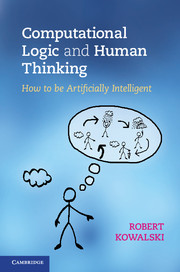Book contents
- Frontmatter
- Contents
- Preface
- Summary and plan of the book
- Introduction
- 1 Logic on the Underground
- 2 The psychology of logic
- 3 The fox and the crow
- 4 Search
- 5 Negation as failure
- 6 How to become a British Citizen
- 7 The louse and the Mars explorer
- 8 Maintenance goals as the driving force of life
- 9 The meaning of life
- 10 Abduction
- 11 The Prisoner’s Dilemma
- 12 Motivations matter
- 13 The changing world
- 14 Logic and objects
- 15 Biconditionals
- 16 Computational Logic and the selection task
- 17 Meta-logic
- Conclusions of the book
- A1 The syntax of logical form
- A2 Truth
- A3 Forward and backward reasoning
- A4 Minimal models and negation
- A5 The resolution rule
- A6 The logic of abductive logic programming
- References
- Index
A1 - The syntax of logical form
Published online by Cambridge University Press: 07 September 2011
- Frontmatter
- Contents
- Preface
- Summary and plan of the book
- Introduction
- 1 Logic on the Underground
- 2 The psychology of logic
- 3 The fox and the crow
- 4 Search
- 5 Negation as failure
- 6 How to become a British Citizen
- 7 The louse and the Mars explorer
- 8 Maintenance goals as the driving force of life
- 9 The meaning of life
- 10 Abduction
- 11 The Prisoner’s Dilemma
- 12 Motivations matter
- 13 The changing world
- 14 Logic and objects
- 15 Biconditionals
- 16 Computational Logic and the selection task
- 17 Meta-logic
- Conclusions of the book
- A1 The syntax of logical form
- A2 Truth
- A3 Forward and backward reasoning
- A4 Minimal models and negation
- A5 The resolution rule
- A6 The logic of abductive logic programming
- References
- Index
Summary
The language of Computational Logic used in this book is an informal and simplified form of Symbolic Logic. Until now, it has also been somewhat vague and imprecise. This additional chapter is intended to specify the language more precisely. It does not affect the mainstream of the book, and the reader can either leave it out altogether, or come back to it later.
In all varieties of logic, the basic building block is the atomic formula or atom for short. In the same way that an atom in physics can be viewed as a collection of electrons held together by a nucleus, atoms in logic are collections of terms, like “train”, “ driver” and “station”, held together by predicate symbols, like “in” or “stop”. Predicate symbols are like verbs in English, and terms are like nouns or noun phrases.
- Type
- Chapter
- Information
- Computational Logic and Human ThinkingHow to Be Artificially Intelligent, pp. 231 - 246Publisher: Cambridge University PressPrint publication year: 2011

